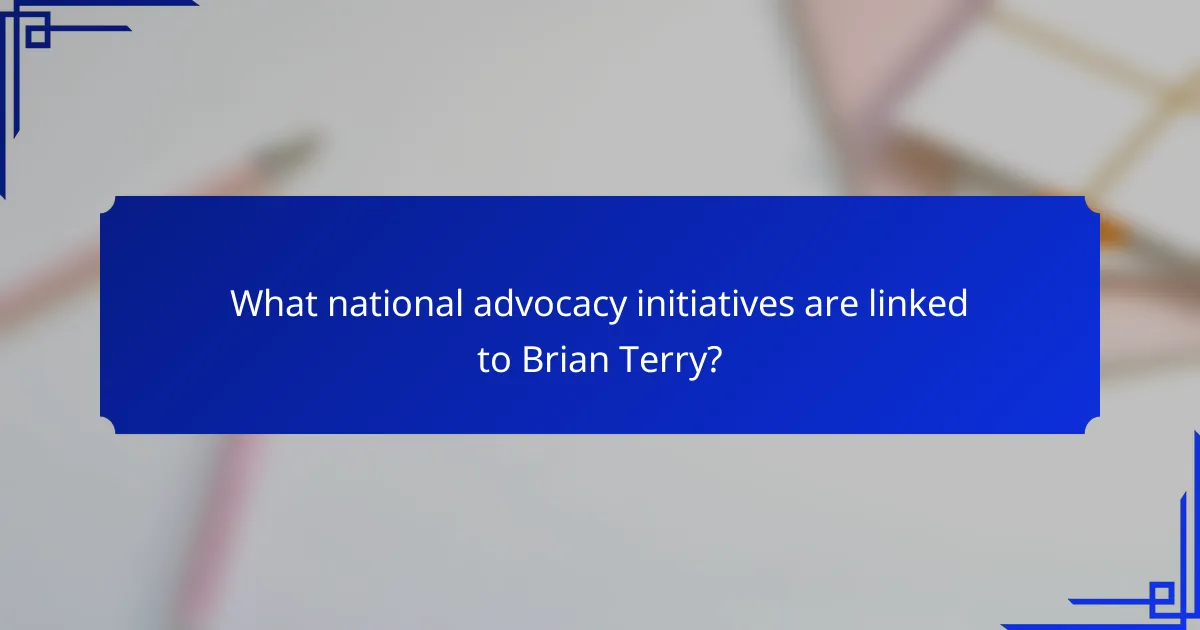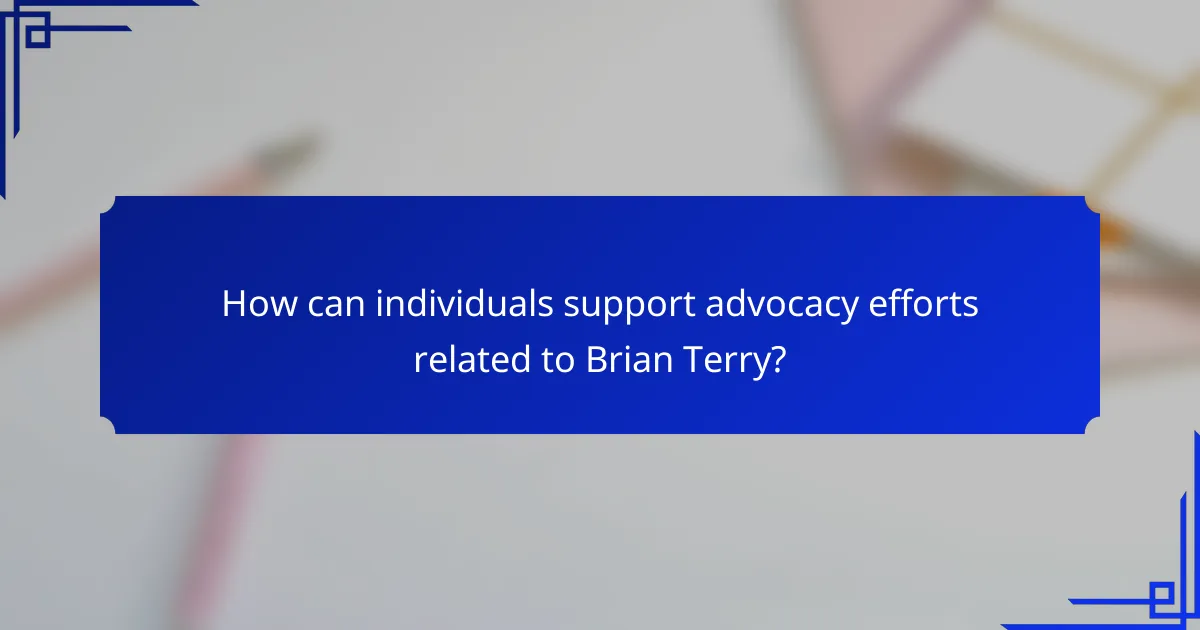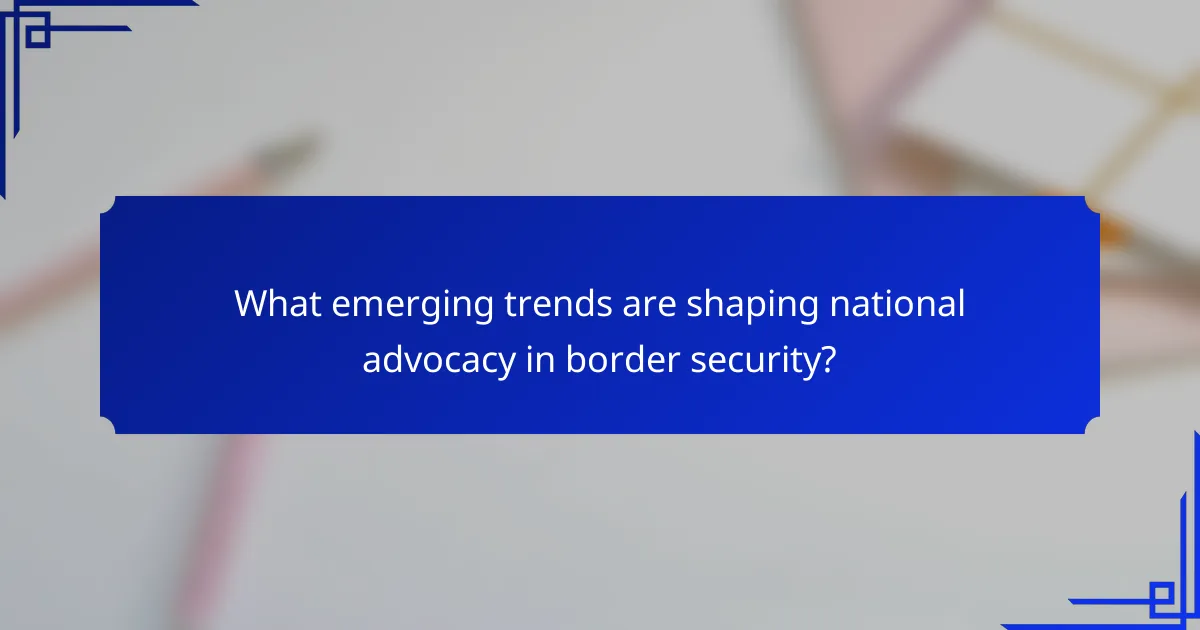Brian Terry, a U.S. Border Patrol agent, tragically lost his life in 2010, a loss that underscored the urgent need for reform in border security and immigration policies. His story has since catalyzed national advocacy initiatives aimed at enhancing safety measures for law enforcement and addressing the complexities of border enforcement. Through his legacy, important discussions and actions continue to shape the future of border security in the United States.

How did Brian Terry’s story impact national advocacy?
Brian Terry’s story significantly influenced national advocacy by highlighting critical issues surrounding border security and immigration enforcement. His tragic death brought attention to the complexities of these topics, prompting discussions and actions aimed at reforming policies and improving safety measures.
Increased awareness of border security issues
The circumstances surrounding Brian Terry’s death underscored the vulnerabilities at the U.S.-Mexico border, leading to heightened public awareness of border security challenges. Advocacy groups began to emphasize the need for comprehensive strategies to address smuggling and illegal crossings.
As a result, community forums and media coverage increased, educating the public about the dangers faced by border patrol agents and the implications for national security. This awareness has spurred grassroots movements advocating for more robust border protection measures.
Influenced policy changes in immigration enforcement
Brian Terry’s story catalyzed discussions that led to significant policy changes in immigration enforcement practices. Lawmakers began to scrutinize existing policies, particularly those related to the use of resources and the coordination between various enforcement agencies.
In response, several initiatives were launched to improve inter-agency collaboration and enhance the effectiveness of immigration enforcement. These changes aimed to prevent similar tragedies and ensure that enforcement actions are conducted with greater accountability and oversight.

What national advocacy initiatives are linked to Brian Terry?
Brian Terry’s legacy has inspired several national advocacy initiatives focused on enhancing border security and supporting law enforcement. These initiatives aim to address the challenges faced by law enforcement agencies and improve safety along the U.S.-Mexico border.
Border security reform campaigns
Border security reform campaigns advocate for comprehensive strategies to strengthen the U.S. border against illegal crossings and trafficking. These campaigns often call for increased funding for technology, personnel, and infrastructure to enhance surveillance and response capabilities.
Key components of these campaigns include promoting the use of advanced surveillance technologies, such as drones and sensors, and advocating for legislative measures that support stricter immigration enforcement. Stakeholders often emphasize the importance of collaboration between federal, state, and local agencies to ensure effective implementation.
Support for law enforcement funding
Support for law enforcement funding initiatives seeks to secure financial resources for police departments and border patrol agencies. This funding is crucial for maintaining operational readiness, acquiring necessary equipment, and providing training to law enforcement personnel.
Advocates highlight the need for sustainable funding models, such as federal grants or state allocations, to ensure that law enforcement agencies can effectively carry out their duties. Engaging community support and building partnerships with local businesses can also enhance funding opportunities and foster trust between law enforcement and the communities they serve.

What are the key events in Brian Terry’s life?
Brian Terry was a U.S. Border Patrol agent whose life and death significantly impacted national discussions on border security and immigration policy. His tragic death in 2010 while on duty highlighted the dangers faced by law enforcement and spurred advocacy for reforms in border protection strategies.
His career as a Border Patrol agent
Brian Terry joined the U.S. Border Patrol in 2007, dedicating his career to protecting the U.S.-Mexico border. He was known for his commitment to duty and his willingness to confront the challenges posed by illegal immigration and drug trafficking. Throughout his service, he participated in numerous operations aimed at securing the border and ensuring the safety of both agents and civilians.
During his time with the Border Patrol, Terry was involved in various initiatives to enhance operational effectiveness, including training programs that emphasized the importance of teamwork and situational awareness in high-risk environments.
The circumstances of his tragic death
Brian Terry was killed on December 14, 2010, during a firefight with suspected drug traffickers in Arizona’s Peck Canyon. His death occurred in the context of increased violence along the border, which was exacerbated by the activities of organized crime syndicates. Terry’s death underscored the perilous conditions faced by Border Patrol agents in the line of duty.
The aftermath of his death led to widespread media coverage and public outcry, prompting calls for improved safety measures for law enforcement personnel. Additionally, it raised awareness about the need for comprehensive immigration reform and better oversight of border security operations.

How can individuals support advocacy efforts related to Brian Terry?
Individuals can support advocacy efforts related to Brian Terry by engaging with organizations dedicated to border security and community safety. This involvement can take various forms, including joining advocacy groups and participating in local events aimed at raising awareness about border issues.
Joining advocacy organizations like the Border Patrol Foundation
Joining advocacy organizations such as the Border Patrol Foundation is a direct way to contribute to the mission of enhancing border security and supporting families of fallen agents. Membership often includes access to resources, networking opportunities, and updates on legislative changes affecting border policies.
Consider participating in fundraising events or volunteer opportunities organized by these groups. Your involvement can help raise awareness and funds for initiatives that support border patrol agents and their families, making a tangible impact in the community.
Participating in community awareness events
Participating in community awareness events is crucial for fostering dialogue about border security and the challenges faced by border patrol agents. These events often include workshops, town hall meetings, and educational seminars that inform the public about relevant issues.
Look for local events organized by advocacy groups or community organizations. Engaging in discussions, sharing information, and inviting others to participate can amplify the message and encourage more people to get involved in advocacy efforts related to Brian Terry’s legacy.

What are the challenges faced by national advocacy initiatives?
National advocacy initiatives often encounter significant challenges that hinder their effectiveness. Key obstacles include political opposition to immigration reform and funding limitations for advocacy groups, both of which can stifle progress and outreach efforts.
Political opposition to immigration reform
Political opposition to immigration reform poses a major challenge for national advocacy initiatives. Various stakeholders, including lawmakers and interest groups, may resist changes due to differing ideologies or fear of political repercussions. This opposition can lead to stalled legislation and a lack of support for necessary reforms.
Advocacy groups must navigate this landscape by building coalitions and engaging in strategic lobbying. Effective communication of the benefits of reform, such as economic growth and community safety, can help sway public opinion and reduce resistance from political entities.
Funding limitations for advocacy groups
Funding limitations significantly impact the capacity of advocacy groups to operate effectively. Many organizations rely on donations, grants, and government funding, which can fluctuate based on economic conditions and political priorities. This uncertainty can restrict their ability to launch campaigns or sustain ongoing initiatives.
To mitigate funding challenges, advocacy groups should diversify their funding sources. This can include seeking partnerships with businesses, applying for a variety of grants, and leveraging crowdfunding platforms. Establishing a strong donor base and transparent financial practices can also enhance trust and encourage contributions.

What role do local communities play in advocacy?
Local communities are vital in advocacy as they provide grassroots support, raise awareness, and influence policy changes. Their collective voice can drive significant social and political change, making it essential for community members to engage actively in advocacy efforts.
Engagement in local policy discussions
Engaging in local policy discussions allows community members to voice their concerns and influence decision-making processes. This can involve attending town hall meetings, participating in public forums, or joining advisory boards. By being present in these discussions, residents can ensure their perspectives are considered in local governance.
To effectively engage, community members should prepare by researching relevant issues and understanding local regulations. They can also bring data or personal stories to illustrate their points, making their arguments more compelling. Active participation can lead to more informed policies that reflect the community’s needs.
Building coalitions for support
Building coalitions involves forming partnerships with other organizations and community groups to strengthen advocacy efforts. These coalitions can amplify voices and resources, creating a more significant impact on local issues. Collaborating with diverse groups can also bring in varied perspectives and expertise, enhancing the advocacy strategy.
To establish effective coalitions, identify shared goals and values among potential partners. Regular communication and joint initiatives can help maintain momentum and foster trust. It’s essential to ensure that all voices within the coalition are heard and valued, which can lead to more robust and united advocacy efforts.

What emerging trends are shaping national advocacy in border security?
Emerging trends in national advocacy for border security are increasingly driven by technology and heightened public interest in immigration issues. These factors are reshaping how advocacy groups operate and engage with policymakers and the public.
Increased use of technology in advocacy
Technology plays a crucial role in modern advocacy efforts for border security. Digital platforms enable organizations to mobilize supporters quickly, share information widely, and engage in real-time discussions about policies and practices.
For instance, social media campaigns can raise awareness and generate public support for specific initiatives, while data analytics help organizations understand public sentiment and tailor their messages accordingly. Tools like online petitions and crowdfunding platforms also facilitate grassroots efforts, allowing individuals to contribute to advocacy initiatives easily.
Growing public interest in immigration issues
Public interest in immigration issues has surged, influencing national advocacy for border security. This growing concern often stems from personal stories, media coverage, and the impact of immigration policies on communities across the country.
Advocacy groups are capitalizing on this interest by organizing events, town halls, and educational campaigns to inform the public about border security challenges and solutions. Engaging storytelling and community involvement are effective strategies to foster a deeper understanding of the complexities surrounding immigration and border policies.
